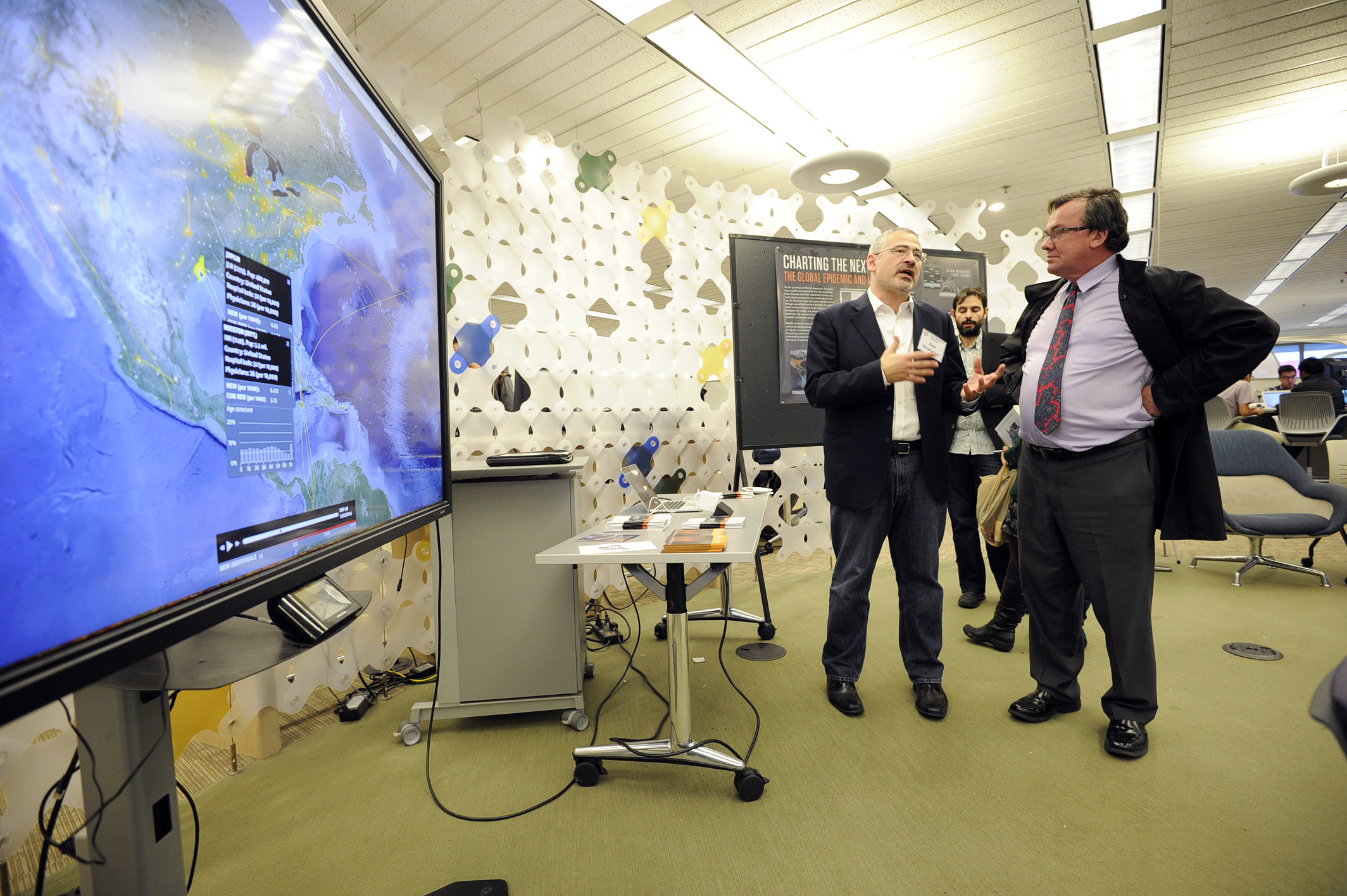by Greg St. Martin
In one section of Snell Library’s Digital Media Commons on Monday afternoon, a large computer screen displayed a dazzling visualization of a hypothetical outbreak of a flu-like disease originating in Chicago. In another section of the room, visitors tested out an interactive health coaching game designed to guide older adults through exercise routines and provide real-time feedback. Elsewhere, digital maps displayed NASA satellite data used to detect trends in water availability on a global scale.
These projects were among the many featured at Northeastern’s sixth Pop Up Open Lab Experience and Reception, where an interdisciplinary group of faculty and students presented their innovative research that works with Big Data. The DMC served as a fitting host for the expo; located on Snell Library’s second floor, the cutting-edge workspace is a media lab and digital creativity center where students and faculty can use a range of technologies such as new animation, audio and video editing, 3-D printing, and game-design software.
One area of the pop up lab featured the work of network scientist Alessandro Vespignani, the Sternberg Family Distinguished Professor of Physics, and his team at Northeastern’s MoBS Lab. They have developed a computational model for visualizing the spread of disease by combining real-world population and human mobility data with elaborate models on disease transmission. In particular, Vespignani’s team is using this approach to track the Ebola outbreak in West Africa and predict its potential spread globally.
Several other projects featured are part of the NULab for Texts, Maps, and Networks: the Viral Texts project, which seeks to discover how particular news stories “went viral” in 19th-century newspapers and magazines, the Early Caribbean Digital Archive; and the Our Marathon: The Boston Bombing Digital Archive project.
The event, titled “Aha! Making Sense from Big Data,” served as the latest installment of the Pop Up Open Lab series sponsored by the Office of the Provost. Previous events have featured topics such as sustainability, the development of playable media, and personal health technologies.
Other Big Data research featured Monday at the event explores critical urban infrastructure systems. Kristian Kloeckl, a new associate professor in the Department of Art + Design and the School of Architecture, is interested in designing interactive visualizations that allow people to explore cities through the eyes of data. He presented work he’s done in collaboration with colleagues at MIT to create a data platform and visualizations combining real-time data from many of Singapore’s urban systems operators—transit, telecommunications, taxis, to name a few.
He said this data could be used to identify where to add more bus routes between bustling transit stations or to help taxi companies identify locations where more drivers are typically needed during intense rainstorms, for example.
“It’s all about bringing decision-making for the city more in sync with how the city actually behaves,” he said.
Dietmar Offenhuber, an assistant professor who holds joint appointments in the College of Arts, Media and Design and the College of Social Sciences and Humanities, showcased two projects that involve using Big Data to visualize waste management systems in cities. In one project, he put GPS tracking devices on 3,000 pieces of trash from Seattle households to map their movement over a two-month period. The other project took place in Brazil, where he used GPS data from trash collectors’ cell phones to map their collection routes.
He said these projects help unveil the “invisible realities” of the urban landscape and can help shed light on ways to make these systems more efficient or organized in entirely new ways that involve more stakeholders.
“It’s about building bottom-up information systems for documenting waste management,” Offenhuber said. “Globally, one of the biggest problems in waste management is there’s hardly any data on it, and the same thing goes for other infrastructure systems as well.”
Originally published in news@Northeastern on October 28, 2014.

